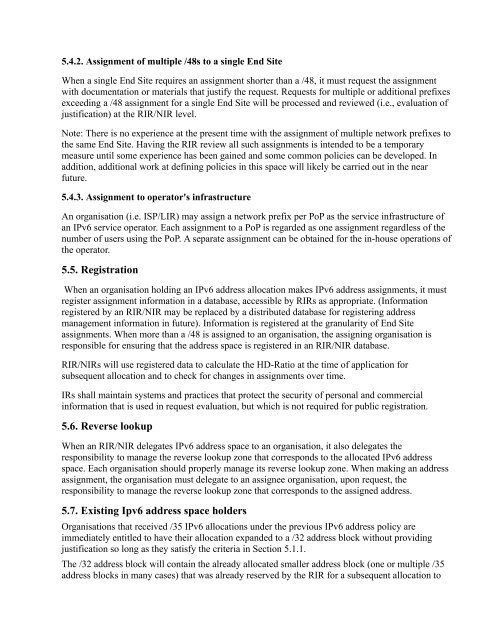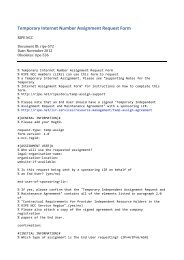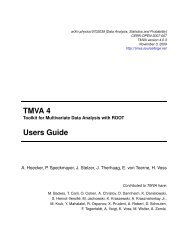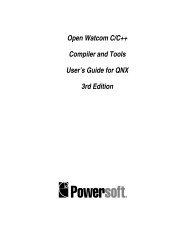IPv6 Address Allocation and Assignment Policy - RIPE NCC
IPv6 Address Allocation and Assignment Policy - RIPE NCC
IPv6 Address Allocation and Assignment Policy - RIPE NCC
You also want an ePaper? Increase the reach of your titles
YUMPU automatically turns print PDFs into web optimized ePapers that Google loves.
5.4.2. <strong>Assignment</strong> of multiple /48s to a single End SiteWhen a single End Site requires an assignment shorter than a /48, it must request the assignmentwith documentation or materials that justify the request. Requests for multiple or additional prefixesexceeding a /48 assignment for a single End Site will be processed <strong>and</strong> reviewed (i.e., evaluation ofjustification) at the RIR/NIR level.Note: There is no experience at the present time with the assignment of multiple network prefixes tothe same End Site. Having the RIR review all such assignments is intended to be a temporarymeasure until some experience has been gained <strong>and</strong> some common policies can be developed. Inaddition, additional work at defining policies in this space will likely be carried out in the nearfuture.5.4.3. <strong>Assignment</strong> to operator's infrastructureAn organisation (i.e. ISP/LIR) may assign a network prefix per PoP as the service infrastructure ofan <strong>IPv6</strong> service operator. Each assignment to a PoP is regarded as one assignment regardless of thenumber of users using the PoP. A separate assignment can be obtained for the in-house operations ofthe operator.5.5. RegistrationWhen an organisation holding an <strong>IPv6</strong> address allocation makes <strong>IPv6</strong> address assignments, it mustregister assignment information in a database, accessible by RIRs as appropriate. (Informationregistered by an RIR/NIR may be replaced by a distributed database for registering addressmanagement information in future). Information is registered at the granularity of End Siteassignments. When more than a /48 is assigned to an organisation, the assigning organisation isresponsible for ensuring that the address space is registered in an RIR/NIR database.RIR/NIRs will use registered data to calculate the HD-Ratio at the time of application forsubsequent allocation <strong>and</strong> to check for changes in assignments over time.IRs shall maintain systems <strong>and</strong> practices that protect the security of personal <strong>and</strong> commercialinformation that is used in request evaluation, but which is not required for public registration.5.6. Reverse lookupWhen an RIR/NIR delegates <strong>IPv6</strong> address space to an organisation, it also delegates theresponsibility to manage the reverse lookup zone that corresponds to the allocated <strong>IPv6</strong> addressspace. Each organisation should properly manage its reverse lookup zone. When making an addressassignment, the organisation must delegate to an assignee organisation, upon request, theresponsibility to manage the reverse lookup zone that corresponds to the assigned address.5.7. Existing Ipv6 address space holdersOrganisations that received /35 <strong>IPv6</strong> allocations under the previous <strong>IPv6</strong> address policy areimmediately entitled to have their allocation exp<strong>and</strong>ed to a /32 address block without providingjustification so long as they satisfy the criteria in Section 5.1.1.The /32 address block will contain the already allocated smaller address block (one or multiple /35address blocks in many cases) that was already reserved by the RIR for a subsequent allocation to












